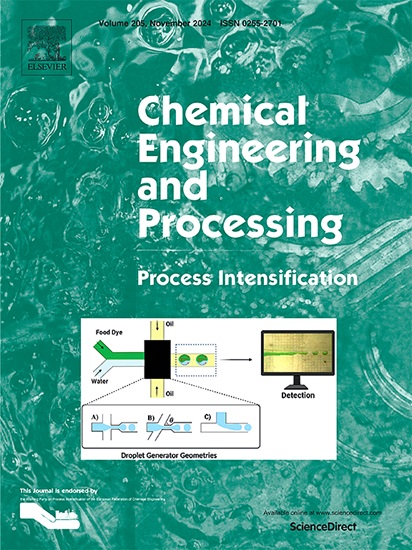高效二氧化碳汽提催化膜集成系统的实验和模拟研究
IF 3.8
3区 工程技术
Q3 ENERGY & FUELS
Chemical Engineering and Processing - Process Intensification
Pub Date : 2025-02-13
DOI:10.1016/j.cep.2025.110216
引用次数: 0
摘要
本文章由计算机程序翻译,如有差异,请以英文原文为准。

Experimental and simulation study of a catalytic-membrane integrated system for efficient CO2 stripping
Global warming, mainly caused by carbon dioxide (CO2) emissions, is rapidly becoming a serious concern. The Carbon Capture, Utilization, and Storage (CCUS) process, particularly the amine-based absorption process, is among the most developed industrial processes for capturing CO2 from anthropogenic and natural sources. However, the energy-intensive nature of the equipment, as well as its high capital cost, inhibits widespread application. A porous hollow fiber membrane contactor (HFMC) is considered a promising technique for solvent regeneration in CO2 capture applications. Recent research on catalyst-assisted solvent regeneration has also shown that nano catalytic materials can reduce solvent regeneration energy costs while increasing CO2 desorption. Therefore, a self-fabricated gas-liquid membrane contactor (GLMC) module integrated with catalytically promoted CO2 desorption to maximize their potential for solvent regeneration is used in this paper. A polytetrafluoroethylene (PTFE) hollow fiber membrane module combined with and without catalytic stripping is tested for CO2 stripping performance under varying gas-liquid flowrates, temperatures, and initial CO2 loading concentrations. Increasing the liquid phase temperature and liquid flowrate significantly improved CO2 stripping, whereas increasing the gas flowrate did not increase stripping flux as much. Adding nanomaterial increased the stripping efficiency of membrane modules from 53 % to 72 % at 80 °C during CO2 stripping experiments. Catalytically assisted systems exhibited improved stripping efficiency from 48 % to 65 % when liquid flow rates were increased from 20 mL/min to 100 mL/min. A mathematical model for the fabricated module is developed for CO2 stripping from rich ethanolamine (MEA) solutions and it is simulated using COMSOL. Model predictions align well with experimental data outcomes.
求助全文
通过发布文献求助,成功后即可免费获取论文全文。
去求助
来源期刊
CiteScore
7.80
自引率
9.30%
发文量
408
审稿时长
49 days
期刊介绍:
Chemical Engineering and Processing: Process Intensification is intended for practicing researchers in industry and academia, working in the field of Process Engineering and related to the subject of Process Intensification.Articles published in the Journal demonstrate how novel discoveries, developments and theories in the field of Process Engineering and in particular Process Intensification may be used for analysis and design of innovative equipment and processing methods with substantially improved sustainability, efficiency and environmental performance.

 求助内容:
求助内容: 应助结果提醒方式:
应助结果提醒方式:


